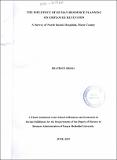| dc.description.abstract | Employee retention is one major challenge facing many organizations today. Human Resource planning has become a concern because the ability to hold on to highly talented core employees can be crucial to future survival. This study examined the Influence of Human Resource Planning (HRP) on Employee Retention in North Imenti Hospitals, Meru County. In particular, the research identified core elements of Human Resource Planning which strongly influence employee retention. HRP is the ongoing process of systematic planning to achieve optimum use of an organization's most valuable asset - its human resources. The objective of human resource planning is to ensure the best fit between employees and jobs, while avoiding manpower shortages or surpluses. A descriptive research methodology was used and a survey approach to achieve the research objectives. The research utilized primary data collected through administration of questionnaires. A total of 62 respondents were engaged to answer questions from selected hospitals in North Imenti, Meru County and used for data analysis. Multiple logistic regression analysis was used to assess the relationship of all the variables. Important to note excluding the variables of the study HRP will leave the dependent variable employee retention negatively affected but insignificantly. Results from the study revealed that human resource planning has a significant influence on increasing the chances of retaining employees. In addition, the Multiple Logistic Regression model was found to be a significant predictor of employee retention showed that at least 30% of the variations in employee retention were explained by human resource planning as a whole. However, these results raise fundamental issues as to why each independent variable was insignificant as depicted by the hypothesis tests and yet the whole model was a significant predictor of employee retention. There is therefore room for further research by future researchers in this subject area. In the order of magnitude of influence despite all of them being insignificant, the independent variable with the highest influence was competency planning, followed by career planning, then succession planning and finally, contingency planning. lt is also important to note that contingency planning and career management decreased the probability of employee retention while competency planning and succession planning increased the probability of employee retention. | en_US |

